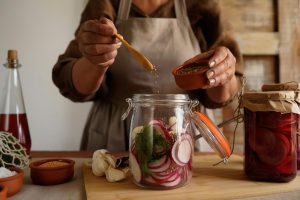Heritage Cooking: Incorporating Family Recipes into Modern Meals
If you were to take a trip down memory lane, what is one of your fondest memories? Chances are, it involves a cherished family recipe. Whether it’s your grandmother’s famous lasagna or your great-grandfather’s secret spice blend, family recipes hold a special place in our hearts. They not only nourish our bodies, but also our souls with a sense of tradition and nostalgia. However, in today’s fast-paced and ever-evolving culinary world, it can be challenging to find the time and inspiration to incorporate these traditional dishes into our modern meals. That’s where the concept of “Heritage Cooking” comes in. It’s the perfect way to honor our past while creating new and delicious memories for future generations. In this article, we will dive into the art of Heritage Cooking and explore how you can seamlessly incorporate your family recipes into your everyday meals.
The Importance of Heritage Cooking
The term Heritage Cooking refers to the practice of cooking and preserving traditional family recipes. It’s not just about cooking the same dishes over and over again, but rather about paying homage to our cultural and familial roots. Our food choices are deeply ingrained in our cultural identity and by preserving and passing on these recipes, we are keeping our heritage alive.
The Connection between Food and Culture
One of the main reasons why family recipes hold such significance is because they are passed down through generations and have become a part of our cultural identity. Food is not just sustenance; it is a medium through which we express and celebrate our culture and heritage. Every dish has a story and a history, and by keeping these traditions alive, we are keeping our cultural identity intact.
The Emotional Value of Family Recipes
Another aspect of Heritage Cooking is the emotional value that these traditional dishes hold. They are not just a source of nourishment, but also a source of nostalgia and comfort. Cooking and enjoying these dishes are not just about the taste, but also about the memories associated with them. Whether it’s the smell of your grandmother’s apple pie or the sight of your father carefully rolling out dough for his famous samosas, these dishes are a reminder of the love, laughter, and togetherness shared with our loved ones.
Incorporating Family Recipes into Modern Meals
While preserving the authenticity of family recipes is important, it can also be fun and exciting to put a modern twist on them. Here are some tips on how you can incorporate your family recipes into your everyday meals:
Get Creative with Ingredients
Rather than sticking to the exact ingredient list, don’t be afraid to experiment and substitute some ingredients with more modern alternatives. For example, instead of using traditional white flour in your family’s pancake recipe, try swapping it with whole wheat flour for a healthier twist. You can also try using different spices or adding new vegetables to dishes for some added flavor and nutrition.
Merge Recipes to Create New Ones
Heritage Cooking is all about honoring traditions, but it doesn’t mean you have to be bound by them. Feel free to combine different family recipes to create new and unique dishes. For example, you can add your grandmother’s secret spice blend to your mother’s favorite chicken dish to create a delicious fusion of flavors.
Get the Whole Family Involved
Cooking is a great way to bring the family together, especially when it involves passing down family recipes. Get everyone involved in the cooking process, from the younger generation learning the ropes to the older generation sharing their tips and tricks. This not only ensures that the recipes are preserved but also creates new memories and strengthens familial bonds.
Preserving Your Family Recipes
Incorporating family recipes into your modern meals is not just about cooking them now, but also about preserving them for future generations. Here are some tips on how you can ensure your family recipes are passed down and remain a part of your heritage:
Write Them Down
While many family recipes are passed down orally, it’s important to write them down for future reference. You can create a handwritten recipe book or use digital platforms to document and store them. Not only does this ensure the accuracy of the recipes, but it also makes them easily accessible for future generations.
Cook and Share Them Often
The best way to preserve family recipes is to cook and share them often. Make it a tradition to cook a family recipe on special occasions or even as a regular part of your weekly meal plan. The more you cook and share these dishes, the more they become ingrained in your family’s culture and traditions.
Pass Them On
Last but not least, don’t forget to pass on your family recipes to the younger generation. Teach your children how to make their favorite dishes and encourage them to continue the tradition by passing on the recipes to their own children in the future.
In conclusion, Heritage Cooking is much more than just cooking traditional dishes. It’s about honoring our heritage, preserving our culture, and creating new memories with our loved ones. By incorporating family recipes into our modern meals, we not only keep our traditions alive but also make them a part of our everyday lives. So, next time you’re in the kitchen, don’t be afraid to add a dash of nostalgia and tradition to your meals with some Heritage Cooking.









